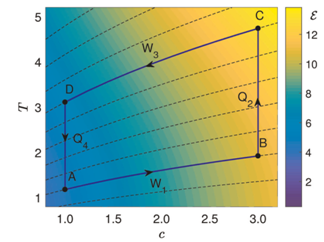New research in quantum engineering by an international team is working towards new methods of operating highly efficient quantum engines for a wide range of industrial, commercial and domestic purposes, enhancing the possibilities for industrial transformation around the world.
Last month, postdoctoral researcher Chen Yangyang from the Shenzhen Institute of Quantum Science and Engineering (SIQSE), working in the research group of Associate Professor Wu Zhigang at Southern University of Science and Technology (SUSTech) was the first author on a paper with Professor Guan Xiwen from the Wuhan Institute of Physics and Mathematics, Chinese Academy of Sciences (CAS) and Professor Adolfo del Campo from the University of Massachusetts Boston as the correspondent authors. The paper was published in authoritative academic journal npj: Quantum Information under the title, “An interaction-driven many-particle quantum heat engine and its universal behavior.”
 Figure: The interaction-driven quantum heat engine circle.
Figure: The interaction-driven quantum heat engine circle.
Universality plays a crucial role in thermodynamics, as emphasized by the description of engines that transform heat and other resources into work. A quantum heat engine is a device that generates power from the heat flow between hot and cold reservoirs. The operation mechanism of the engine can be described by the laws of quantum mechanics.
These engines have received significant attention from researchers in recent years, as theoretical studies have found quantum many-body systems with interaction exhibit novel properties which is helpful to improve the performance of the heat engines. From the perspective of experimental achievement, the techniques of manipulating interacting ultra-cold atoms are matured. The interacting atomic gas is a promising candidate for the realization of quantum many-body heat engine.
The paper proposed a unique idea in controlling quantum heat engines by changing the interacting strength between atoms. They theoretically calculated the efficiency and work of this heat engine by using exactly solvable mode and Luttinger liquid theory, and found some universal behavior. Their research found that the efficiency of the heat engine is independent of the temperature of the heat source and only depends on the ratio of sound velocities at the different states when the quantum gas being in the Luttinger liquid phase. When the engine works near the quantum critical region, the average work exhibits a maximum value which indicates the quantum gases perform better than classical gases. They also proposed a possible experimental realization of the heat engine. This work reveals how the universal behavior of one dimensional quantum gases emerges in the heat engine, and can provide insightful information for further experimental study.
The innovative use of the integrable model and the low-dimensional quantum field theory help researchers to analyze the quantum heat engine whose work medium is the one-dimensional contact interacting Bose gas. They have obtained analytical expressions of the main parameters such as efficiency and work. Using these properties and the advantages of cold atom gas, the paper recommends the realization of the quantum heat engine by controlling the intensity of interactions between atoms. The theoretical confirmation of their proposition means that the interaction could achieve new effect which is similar to the magnetothermal and piezothermic effects. This study has not only proved the feasibility of the quantum heat engine theoretically but also provides a pathway for experimental realization.

Figure:a) The relation between efficiency h, work W and atom density n. b) The phase diagram and the heat engine’s circle in different regions. c) The gradient of energy respect to interaction for the heat engine’s circle in different regions. Here T is temperature, m is chemical potential, c is the strength of interaction.
Chen Yangyang is the first author of the paper. Professor Guan Xiwen and Professor Adolfo del Campo are co-authors of the paper. Other supporting authors included Gentaro Watanabe from Department of Physics and Zhejiang Institute of Modern Physics at Zhejiang University & Yu Yicong at State Key Laboratory of Magnetic Resonance and Atomic and Molecular Physics, Innovation Academy for Precision Measurement Science and Technology (CAS).
The research work was supported by the John Templeton Foundation, the National Key R&D Program of China, the National Natural Science Foundation of China (NSFC), Zhejiang Provincial Natural Science Foundation Key Project, Fundamental Research Funds for Central Universities, Zhejiang University 100 Plan, Thousand Young Talents Program of China and the China Postdoctoral Science Foundation Grant.
Paper link: https://www.nature.com/articles/s41534-019-0204-5
Proofread By
Photo ByShenzhen Institute of Quantum Science and Engineering